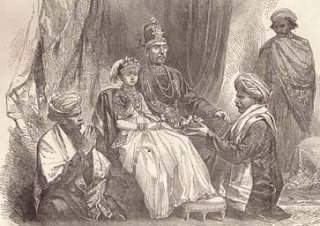
Dewan Kunta Basava and his blood-curdling sport
“Saga of the Somayandra Family
(By: C.P. Belliappa)
The following story is adapted from a narrative by Major Somayandra T. Appachanna, a robust nonagenarian, currently living in Pune. His cousin S.M. Nanjappa forwarded the write-up to me.
Somayandra family was based near Hathoor village located between Gonikoppal and Virajpet. They were hereditary chieftains of several villages in the area. Many Kodava families were awarded ‘copper plate edicts’ by the Haleri rajas bestowing them this privilege of being chieftains. The large joint family of Somayandra lived in a two-storied Ainemane. As was the practice, the family had to collect and pay tax to the raja and also be ready to take to arms in case of any threat to the dominion. This tradition continued for several decades and the Somayandra family lived in peace and prosperity within their sphere of influence.
It was during the reign of Chikka Veerarajendra (circa 1825) that the family fell out of favour with the erratic juvenile raja who was misguided by his wicked dewan: Kunta Basava. Dewan Kunta Basava instigated and convinced Chikka Veerarajendra that the Somayandra family was plotting a rebellion against his rule. In a fit of paranoid rage the raja ordered the dreaded ‘kuthi nasha’ of the Somayandra family – i.e., every member of the okka to be eliminated. The evil Dewan Kunta Basava came up with a diabolic plan to destroy the family.
However, just a few weeks earlier an event took place in the otherwise well-knit Somayandra family. Two brothers in the okka had an acrimonious fight with the elders. The younger brother was named Madayya, but the name of the elder brother is lost with the passage of time. After a meeting of the elders in the family it was decided to mete out a very harsh punishment on the two brothers. The duo were excommunicated and ordered to leave the Ainemane. This process was sealed with a ritual known as ‘Kare-Kithuva’ which means ‘Disownment’. The ritual entailed tearing a piece of cloth in front of ‘Devada Bolucha’ (sacred lamp) by the head of the family.
Madayya and his brother left their village and found shelter in nearby Chembebellur village.
On that fateful day, the Somayandra family was celebrating Puthari Kolu, and there was a great deal of singing, dancing and gaiety. All the women folk watched the goings on from the first floor balcony. Soon the ladies got busy with serving the feast and the men were goaded to make it the ‘last-mug-of-toddy’ and sit for lunch. Amidst raucous conversation everyone enjoyed the meal and were about to get up when a bullock cart laden with several vessels pulled up near the Ainemane. Ominously the cart was followed by a posse of armed Siddhis.
The man who was driving the cart got down and spoke very courteously to the Pattedar of Somayandra family and told him that he had brought ‘prasada’ sent by the raja especially for the family. It was customary for the raja to send ‘prasada’ to village heads whenever a puja was performed in the palace. However, here was a cartload of ‘prasada’ in the form of payasa for the entire village.
Even before any questions could be asked a few servants in the entourage unloaded the vessels and started serving the payasa to the people who were still sitting in front of their banana leaves.
It was considered an honour to receive prasada from the palace and the children lost no time in lapping it up. Soon the elders too tentatively started eating the payasa. The Siddhis watched-over till everyone consumed the payasa.
Within a short time the children complained of stomach ache and started collapsing one after the other. The Pattedar and the elders soon realized what was happening. Men, women and children were writhing in pain and dropping dead. The entourage from the palace left only after ensuring that the poisoned payasa had done the ‘kuthi nasha’ of the Somayandra family.
Ironically, the excommunicated Madayya and his brother were the only survivors. According to Major Appachanna it was Dewan Chepudira Ponnappa, who after Chikka Veerarajendra was deposed, issued a public proclamation to ascertain the possibilities of any member of the Somayandra family having survived the ‘kuthi nasha’. Madayya had married and had a family while his elder brother had remained a bachelor. When Madayya’s family was finally traced, Dewan Ponnappa used his influence to re-establish the Somayandra okka.

